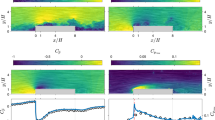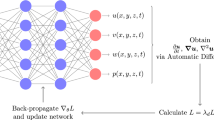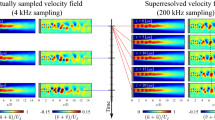Abstract
Particle image velocimetry (PIV) data of high Reynolds number unsteady turbulent flows are often undersampled in time; this leads to aliasing of important spectral content. The present work proposes a novel data-driven estimation technique that uses oversampled sparsely placed surface-mounted pressure sensors and long short-term memory neural networks to resolve the aliased transient velocity dynamics from undersampled PIV data. The method leverages the time-resolved pressure dynamics to estimate the temporal evolution of a proper orthogonal decomposition-based low-dimensional subspace of the velocity field. The proposed approach is demonstrated on a PIV dataset of a high Reynolds number turbulent separated flow over a Gaussian speed-bump benchmark geometry (\(\text{Re}_{H}=2.26\times 10^{5}\), where H is the Bump height). The 15 Hz PIV data is super-resolved to 2 kHz, and spectral analysis of the flowfields is conducted to educe the originally aliased unsteady dynamics of the turbulent separation bubble. The estimator is shown to accurately reconstruct the Reynolds shear stress from unseen sensor data, demonstrating its generalizability to resolve the coherent motions. The estimated velocity spectra show distributions consistent with those of other separated flows.











Similar content being viewed by others
Availability of data and materials
The PIV and surface-pressure data are available upon reasonable request.
References
Annamalai H (2022) Detailed characterization of turbulent separated flow dynamics and boundary layer evolution over a speed-bump geometry. Master’s thesis, University of Washington
Balin R, Jansen KE (2021) Direct numerical simulation of a turbulent boundary layer over a bump with strong pressure gradients. J Fluid Mech 918
Bonnet JP, Cole DR, Delville J et al (1994) Stochastic estimation and proper orthogonal decomposition: complementary techniques for identifying structure. Exp Fluids 17(5):307–314
Brunton SL, Noack BR (2015) Closed-loop turbulence control: progress and challenges. Appl Mech Rev 67(5)
Cherry N, Hillier R, Latour M (1984) Unsteady measurements in a separated and reattaching flow. J Fluid Mech 144:13–46
Discetti S, Raiola M, Ianiro A (2018) Estimation of time-resolved turbulent fields through correlation of non-time-resolved field measurements and time-resolved point measurements. Exp Therm Fluid Sci 93:119–130
Durgesh V, Naughton J (2010) Multi-time-delay LSE-POD complementary approach applied to unsteady high-Reynolds-number near wake flow. Exp Fluids 49(3):571–583
Fang X, Tachie MF (2019) On the unsteady characteristics of turbulent separations over a forward-backward-facing step. J Fluid Mech 863:994–1030
Fukami K, Fukagata K, Taira K (2021) Machine-learning-based spatio-temporal super resolution reconstruction of turbulent flows. J Fluid Mech 909
Goodfellow I, Bengio Y, Courville A (2016) Deep learning. MIT press
Gray PD, Gluzman I, Thomas FO, et al. (2022) Experimental characterization of smooth body flow separation over wall-mounted Gaussian bump. In: AIAA SCITECH 2022 Forum, p 1209
Harun Z, Monty JP, Mathis R et al (2013) Pressure gradient effects on the large-scale structure of turbulent boundary layers. J Fluid Mech 715:477–498
Hochreiter S, Schmidhuber J (1997) Long short-term memory. Neural Comput 9(8):1735–1780
Hosseini Z, Martinuzzi RJ, Noack BR (2015) Sensor-based estimation of the velocity in the wake of a low-aspect-ratio pyramid. Exp Fluids 56(1):1–16
Hudy LM, Naguib AM, Humphreys WM Jr (2003) Wall-pressure-array measurements beneath a separating/reattaching flow region. Phys Fluids 15(3):706–717
Hutchins N, Marusic I (2007) Large-scale influences in near-wall turbulence. Philos Trans R Soc A Math Phys Eng Sci 365(1852):647–664
Iyer PS, Malik MR (2021) Wall-modeled LES of flow over a Gaussian bump. In: AIAA Scitech 2021 Forum, p 1438
Jin X, Laima S, Chen WL et al (2020) Time-resolved reconstruction of flow field around a circular cylinder by recurrent neural networks based on non-time-resolved particle image velocimetry measurements. Exp Fluids 61(4):1–23
Manohar KH, Morton C, Ziadé P (2022) Sparse sensor-based cylinder flow estimation using artificial neural networks. Phys Rev Fluids 7(2):024,707
Marusic I, Mathis R, Hutchins N (2010) Predictive model for wall-bounded turbulent flow. Science 329(5988):193–196
Mathis R, Hutchins N, Marusic I (2009) Large-scale amplitude modulation of the small-scale structures in turbulent boundary layers. J Fluid Mech 628:311–337
Mohammed-Taifour A, Weiss J (2016) Unsteadiness in a large turbulent separation bubble. J Fluid Mech 799:383–412
Moschopoulos PG (1985) The distribution of the sum of independent gamma random variables. Ann Inst Stat Math 37(1):541–544
Nobach H, Tropea C, Cordier L, et al (2007) Review of some fundamentals of data processing. In: Tropea C, Yarin AL, Foss JF (eds) Handbook of experimental fluid mechanics. Springer, New York, chap 22, pp 1346–1348
Ozawa Y, Nagata T, Nonomura T (2022) Spatiotemporal superresolution measurement based on POD and sparse regression applied to a supersonic jet measured by PIV and near-field microphone. J Vis 25(6):1169–1187
Robbins ML, Samuell M, Annamalai H, et al. (2021) Overview of validation completeness for Gaussian speed-bump separated flow experiments. In: AIAA Scitech 2021 Forum, p 0969
Schneiders JF, Dwight RP, Scarano F (2014) Time-supersampling of 3D-PIV measurements with vortex-in-cell simulation. Exp Fluids 55(3):1–15
Shur ML, Spalart PR, Strelets MK et al (2021) Direct numerical simulation of the two-dimensional speed bump flow at increasing Reynolds numbers. Int J Heat Fluid Flow 90(108):840
Slotnick JP (2019) Integrated CFD validation experiments for prediction of turbulent separated flows for subsonic transport aircraft. In: NATO science and technology organization, meeting proceedings RDP, STO-MP-AVT-307
Slotnick JP, Khodadoust A, Alonso J et al. (2014) CFD vision 2030 study: a path to revolutionary computational aerosciences. Tech. Rep. CR-2014-218178, Natl. Aeronaut. Space Admin., Langley Research Center, Hampton, Virginia
Tinney C, Coiffet F, Delville J et al (2006) On spectral linear stochastic estimation. Exp Fluids 41:763–775
Tinney C, Ukeiley L, Glauser MN (2008) Low-dimensional characteristics of a transonic jet. part 2. Estimate and far-field prediction. J Fluid Mech 615:53–92
Tsuji Y, Marusic I, Johansson AV (2016) Amplitude modulation of pressure in turbulent boundary layer. Int J Heat Fluid Flow 61:2–11
Tu JH, Griffin J, Hart A et al (2013) Integration of non-time-resolved PIV and time-resolved velocity point sensors for dynamic estimation of velocity fields. Exp Fluids 54:1–20
Westerweel J, Scarano F (2005) Universal outlier detection for PIV data. Exp Fluids 39(6):1096–1100
Williams O, Samuell M, Sarwas ES et al. (2020) Experimental study of a CFD validation test case for turbulent separated flows. In: AIAA Scitech 2020 Forum, p 0092
Williams O (2014) Density effects on turbulent boundary layer structure: from the atmosphere to hypersonic flow. PhD thesis, Princeton University
Williams O, Samuell M, Robbins ML et al (2021) Characterization of separated flowfield over Gaussian speed-bump CFD validation geometry. In: AIAA Scitech 2021 Forum, p 1671
Wu W, Meneveau C, Mittal R (2020) Spatio-temporal dynamics of turbulent separation bubbles. J Fluid Mech 883
Zhang Y, Cattafesta LN, Ukeiley L (2020) Spectral analysis modal methods (SAMMs) using non-time-resolved PIV. Exp Fluids 61:1–12
Funding
The authors thank the Natural Sciences and Engineering Research Council (NSERC) of Canada for their support through the Discovery Grant, Research Tool & Instrumentation and Postgraduate Scholarship programs as well as the Government of Alberta through the AGES scholarship program. The authors would also like to gratefully acknowledge funding from Boeing Commercial Airplanes that has supported the creation of the Gaussian speed-bump separated flow test case and the test articles at the University of Washington utilized for this study.
Author information
Authors and Affiliations
Contributions
KHM wrote the main manuscript, conducted experiments and the data analysis. O.W. supervised the project and the execution of the experiments as well as the analysis. RJM and CM supervised the project and the analysis and provided funding. All authors actively contributed to the preparation of the manuscript.
Corresponding author
Ethics declarations
Conflict of interest
The authors report no conflict of interest.
Ethical approval
Not applicable.
Additional information
Publisher's Note
Springer Nature remains neutral with regard to jurisdictional claims in published maps and institutional affiliations.
Supplementary Information
Below is the link to the electronic supplementary material.
Supplementary file 1 (mp4 491 KB)
Supplementary file 2 (mp4 713 KB)
Appendix A Hyperparameter search
Appendix A Hyperparameter search
Various configurations of \((N_{\text {train}},\,n,\,f_{\text {cut-off}})\) used in the hyperparameter study are summarized along with the other relevant network parameters and corresponding error metrics in Table 1.
Rights and permissions
Springer Nature or its licensor (e.g. a society or other partner) holds exclusive rights to this article under a publishing agreement with the author(s) or other rightsholder(s); author self-archiving of the accepted manuscript version of this article is solely governed by the terms of such publishing agreement and applicable law.
About this article
Cite this article
Manohar, K.H., Williams, O., Martinuzzi, R.J. et al. Temporal super-resolution using smart sensors for turbulent separated flows. Exp Fluids 64, 101 (2023). https://doi.org/10.1007/s00348-023-03639-2
Received:
Revised:
Accepted:
Published:
DOI: https://doi.org/10.1007/s00348-023-03639-2




